Can Social Innovation Make a Change in European and Mediterranean Marginalized Areas? Social Innovation Impact Assessment in Agriculture, Fisheries, Forestry, and Rural Development
Abstract
1. Introduction
2. Theoretical Background
2.1. The Definition of Social Innovation
2.2. The Impacts of Social Innovation
2.2.1. Types of Impact
2.2.2. Domains of Impacts
2.2.3. Scale of Impacts
3. Assessment Framework
4. Methods and Material
4.1. SI Initiatives under Examination
4.2. Data Collection and Analysis
5. Results
5.1. Main Impacts of the Nine SI Initiatives
5.2. Trends among Variables Measuring the Impacts of SI Initiatives
5.3. Trends among Variables Measuring the Impacts of SI Initiatives and Cases of SI
5.3.1. Axis 1: Impacts of SI Initiatives on the Four Domains
5.3.2. Axis 2: Impacts of SI Initiatives on Marginalization and in Addressing EU Societal Challenges
5.3.3. Axis 3: Magnitude of Impacts of SI Initiatives within the Territory
6. Discussion
6.1. Positive and Negative Effects of SI Iinitiatives
6.2. SI Reduced Certain Forms of Marginality While Addressing Current EU Societal Challenges and Territorial Disparities
6.3. SI Generated Impacts Mainly within Their Local Territories
6.4. SI impacted Mainly on the Social, Economic, and Institutional Domains
6.5. SI Achieved Multi-Level Impacts
7. Conclusions
Author Contributions
Funding
Institutional Review Board Statement
Informed Consent Statement
Data Availability Statement
Acknowledgments
Conflicts of Interest
Appendix A
| Category | Name | Meaning | WOM | SEA | VAZ | LUM | FIN | CAR | DAI | LAG | FLE | Median | Average | Min value | Max value |
|---|---|---|---|---|---|---|---|---|---|---|---|---|---|---|---|
| A. Type of Impact | A1 | Proportion of marginalization problems improved by the SI initiative | 1.00 | 0.00 | 0.00 | 0.00 | 1.00 | 1.00 | 0.43 | 0.59 | 0.75 | 0.59 | 0.53 | 0.00 | 1.00 |
| A2 | Level of improvement in European societal challenges due to the SI initiative | 0.82 | 0.71 | 0.90 | 0.75 | 0.89 | 0.98 | 0.88 | 0.92 | 0.89 | 0.89 | 0.86 | 0.71 | 0.98 | |
| B. Domains of Impacts | B1 | Balance between positive to negative significant impacts due to the SI initiative in the four domains (social, economic, environmental, institutional) | 1.00 | 0.00 | 0.18 | 0.21 | 0.18 | 0.09 | 0.01 | 0.18 | 0.56 | 0.18 | 0.27 | 0.00 | 1.00 |
| B2 | Proportion of the number of impacts of the SI initiative in the four domains which were positive | 1.00 | 0.86 | 1.00 | 1.00 | 0.83 | 0.67 | 0.97 | 0.97 | 1.00 | 0.97 | 0.92 | 0.67 | 1.00 | |
| B2_soc | Social | 1.00 | 1.00 | 1.00 | 1.00 | 0.90 | 1.00 | 1.00 | 1.00 | 1.00 | 1.00 | 0.99 | 0.90 | 1.00 | |
| B2_eco | Economic | 1.00 | 0.86 | 1.00 | 1.00 | 0.70 | 1.00 | 1.00 | 1.00 | 1.00 | 1.00 | 0.95 | 0.70 | 1.00 | |
| B2_env | Environmental | 1.00 | 0.75 | 1.00 | 1.00 | 1.00 | 0.00 | 0.00 | 1.00 | 0.00 | 1.00 | 0.64 | 0.00 | 1.00 | |
| B2_ins | Governance | 1.00 | 0.86 | 1.00 | 1.00 | 0.67 | 1.00 | 1.00 | 0.86 | 1.00 | 1.00 | 0.93 | 0.67 | 1.00 | |
| B3 | Level of effects of the SI initiative in the four domains inside and outside of the territory | 0.75 | 0.73 | 0.72 | 0.63 | 0.58 | 0.64 | 0.81 | 0.71 | 0.81 | 0.72 | 0.71 | 0.58 | 0.81 | |
| B3_soc | Social | 0.87 | 0.75 | 0.80 | 0.63 | 0.68 | 0.88 | 0.94 | 0.72 | 0.85 | 0.80 | 0.79 | 0.63 | 0.94 | |
| B3_eco | Economic | 0.78 | 0.83 | 0.73 | 0.63 | 0.50 | 0.69 | 0.96 | 0.70 | 0.75 | 0.73 | 0.73 | 0.50 | 0.96 | |
| B3_env | Environmental | 0.66 | 0.78 | 0.67 | 0.69 | 0.60 | 0.44 | 0.50 | 0.77 | 0.81 | 0.67 | 0.66 | 0.44 | 0.78 | |
| B3_ins | Governance | 0.68 | 0.55 | 0.58 | 0.58 | 0.56 | 0.56 | 0.81 | 0.58 | 0.86 | 0.58 | 0.64 | 0.55 | 0.81 | |
| B4 | Level of improvement in governance aspects due to the SI initiative. | 0.88 | 0.71 | 0.63 | 0.71 | 0.33 | 1.00 | 0.78 | 0.58 | 0.96 | 0.71 | 0.73 | 0.33 | 1.00 | |
| C. Scale of Impacts | C1 | Level of effects of the SI initiative inside the territory in the four domains | 0.82 | 0.68 | 0.80 | 0.75 | 0.61 | 0.64 | 0.87 | 0.77 | 0.88 | 0.77 | 0.76 | 0.61 | 0.87 |
| C2 | Level of effects of the SI initiative outside the territory in the four domains | 0.62 | 0.75 | 0.70 | 0.50 | 0.55 | 0.67 | 0.75 | 0.64 | 0.75 | 0.67 | 0.66 | 0.50 | 0.75 |
| Category of Impacts | Name and Meaning of Indicator | Respondent Type | |
|---|---|---|---|
| A. Type of Impact | A1 | Proportion of marginalization problems improved by the SI initiative, as perceived by stakeholders. The marginalization problems include: (i) physical geography constraints; (ii) infrastructural access limitations; (iii) socio-economic conditions. The reduction in the number of marginalization problems in the territory is measured by comparing the total number of problematic elements/aspects improved by the social innovation initiative with the problematic elements/aspects. | Stakeholders taking part in the focus group |
| A2 | Level of improvement in European societal challenges due to the SI initiative, according to the actors. The indicators refer to the European Societal Challenges as identified in the Europe 2020 strategy (see https://ec.europa.eu/programmes/horizon2020/en/h2020-section/societal-challenges). The European societal challenges are: (i) health; (ii) ageing of population; (iii) income, jobs, education; (iv) sustainable agriculture and food security; (v) water use and quality; (vi) secure, clean and efficient energy; (vii) smart, green and integrated transport; (viii) environment and climate change; (ix) inclusive societies; innovative societies; (x) secure societies. | Core group; project partners | |
| B. Domains of Impacts | B1 | Balance between positive to negative significant impacts due to the SI initiative in the four domains, according to perception of stakeholders. The indicator measures the balance between the 4 greatest positive impacts and the 4 greatest negative impacts due to the Social Innovation initiative in the environmental, economic, social and institutional domains. Stakeholders attribute the scores based on the following four criteria: (i) capability of the social innovation to keep under direct control the impact; (ii) frequency of the activities determining the impacts; (iii) magnitude (intensity) of the impact; (iv) sensitivity of the local community to the impact. | Stakeholders taking part in the focus group |
| B2 | Proportion of the number of impacts of the SI initiative in the four domains which were positive, according to perception of stakeholders. The indicator measures the number of impacts of the social innovation initiative in the four domains. The elements refer to environmental, economic, social and institutional domains. For each domain, a detailed list of elements has been provided and analyzed by the stakeholders who participated in the focus group. | Stakeholders taking part in the focus group | |
| B2_soc | Social domain: life satisfaction and happiness, solidarity and mutual trust among the members of the community, civic engagement, safety and security of community members, food security, access to quality education for children and youths, options for life-long learning of adults, housing, welfare and social expenditure, gender balance, people at risk of poverty and social exclusion, vulnerable groups, health conditions and well-being of the members of the community, quality of service of general interest. | ||
| B2_eco | Economic domain: household income; investments on infrastructure that affects the community, investments on economic and social initiatives in the community; investments in research, experiments and innovation that increase knowledge; value added produced by the production, value chains; access to credit and insurance; wages of employees and workers; employment opportunities and quality; labor conditions in the sector in the territory. | ||
| B2_env | Environmental domain: pollutant emissions to air; carbon sequestration; water (e.g., consumption, quality); landscape and ecosystems; raw materials (e.g., wood, feedstock, fish); energy (e.g., consumption, percentage of renewable sources); biodiversity (e.g., animal and plant species, habitats, protected areas, genetic resources); soil (e.g., fertility, erosion, landslide stability); waste and/or effluents; noise or other types of disturbances (e.g., light pollution). | ||
| B2_ins | Institutional domain: stakeholders empowerment and representativeness in the decision-making process; capability of public administrations to manage collaboration, dialogue and/or conflicts; capability of the community and public administrations to adapt to crises and disturbances; coherence of local policies and actions with international and national policies and actions; legality; transparency and open access to data and knowledge sharing; accountability of both private and public organizations; trust in public institutions; professional capability of public officials and administrations. | ||
| B3 | Level of effects of the social innovation initiative in the four domains, according to the actors. The indicator measures the extent of the effects of the social innovation initiative inside and outside the territory in the four domains. The indicator is based on a Likert Scale from -2 (negative) to + 2 (positive) in relation to four domains (economy, social cohesion*, public administrations* and the environment). | Core group; project partners; beneficiaries. | |
| B3_soc | Same as B2_soc | ||
| B3_eco | Same as B2_eco | ||
| B3_env | Same as B2_env | ||
| B3_ins | Same as B2_ins | ||
| B4 | Level of improvement in governance aspects due to the SI initiative, according to the actors. The indicator measures the level of improvement in different aspects of governance due to the social innovation initiative, as perceived by the innovator(s), follower(s) and project partners. Respondents score the improvement for 13 aspects of governance: (i) options for citizen engagement; (ii) stakeholder consultation; (iii) voice of minorities; (iv) gender balance; (v) transparency; (vi) bureaucracy; (vii) capacity of public administrations; (viii) policy initiatives; (ix) legal framework; (x) conflict of interests and corruption; (xi) quality of public services; (xii) market and economy; (xiii) other. | Core group; project partners | |
| C.Scale of Impacts | C1 | Level of effects of the SI initiative inside the territory in the four domains, according to the actors. The indicator measures the extent of the effects of the social innovation initiative inside the territory in the four domains. The indicator is based on a Likert Scale from -2 (negative) to + 2 (positive) in relation to: (i) economy; (ii) social cohesion; (iii) public administrations; (iv) the environment. | Core group; project partners; beneficiaries. |
| C2 | Level of effects of the SI initiative outside the territory in the four domains, according to the actors. The indicator measures the extent of the effects of the social innovation initiative outside the territory in the four domains. The indicator is based on a Likert Scale from -2 (negative) to + 2 (positive) in relation to: (i) economy; (ii) social cohesion; (iii) public administrations; (iv) the environment. | Core group; project partners; beneficiaries. | |
References
- BEPA–Bureau of European Policy Advisors. Social Innovation: A Decade of Changes; Publications Office of the European Union: Luxembourg, 2014. [Google Scholar]
- EC–European Commission. Social Innovation: A Decade of Changes; European Commission: Brussels, Belgium, 2014. [Google Scholar]
- Moulaert, F. The International Handbook on Social Innovation: Collective Action, Social Learning and Transdisciplinary Research; Edward Elgar Publishing: Cheltenham, UK, 2013. [Google Scholar]
- Swyngedouw, E. Civil society, governmentality and the contradictions of governance-beyond-the-state: The Janus-face of social innovation. In Social Innovation and Territorial Development; MacCallum, D., Moulaert, F., Hillier, J., Haddock, S.V., Eds.; Ashgate: Farnham, UK, 2009. [Google Scholar]
- Van den Broeck, P.; Mehmood, A.; Paidakaki, A.; Parra, C. Social Innovation as Political Transformation. Thoughts for a Better World; Edward Elgar Publishing: Cheltenham, UK, 2019. [Google Scholar]
- Price, M.; Miller, D.; McKeen, M.; Slee, B.; Nijnik, M. Categorisation of Marginalised Rural Areas (MRAs) Deliverable 3.1.; Social Innovation in Marginalised Rural Areas Project (SIMRA); European Commission: Brussels, Belgium, 2017; p. 57. [Google Scholar]
- Wiesinger, G. The importance of social capital in rural development, networking and decision-making in rural areas. J. Alp. Res. 2009, 94–95. [Google Scholar] [CrossRef]
- Osburg, T.; Schmidpeter, R. Social Innovation: Solutions for a Sustainable Future; Springer: Heidelberg, Germany, 2013. [Google Scholar]
- Mehmood, A.; Parra, C. Social Innovation in an unsustainable world. In The International Handbook on Social Innovation: Collective Action, Social Learning and Transdisciplinary Research; Moulaert, F., MacCallum, D., Mehmood, A., Hamdouch, A., Eds.; Edward Elgar Publishing: Cheltenham, UK, 2013; pp. 53–66. [Google Scholar]
- Repo, P.; Matschoss, K. Social Innovation for Sustainability Challenges. Sustainability 2020, 12, 319. [Google Scholar] [CrossRef]
- Varadarajan, R. Innovating for sustainability: A framework for sustainable innovations and a model of sustainable innovations orientation. J. Acad. Mark. Sci. 2017, 45, 14–36. [Google Scholar] [CrossRef]
- Van Marrewijk, M. Concepts and definitions of CSR and corporate sustainability: Between agency and communion. J. Bus. Ethics 2003, 44, 95–105. [Google Scholar] [CrossRef]
- Popescu, C.R.; Popescu, G. An Exploratory Study Based on a Questionnaire Concerning Green and Sustainable Finance, Corporate Social Responsibility, and Performance: Evidence from the Romanian Business Environment. J. Risk Financ. Manag. 2019, 12, 162. [Google Scholar] [CrossRef]
- Rxhepi, G.; Kurtishi, S.; Bexheti, G. Corporate Social Responsibility (CSR) and Innovation—The drivers of business growth? Procedia Soc. Behav. Sci. 2013, 75, 532–541. [Google Scholar] [CrossRef]
- Bock, B.B. Social innovation and sustainability; how to disentangle the buzzword and its application in the field of agriculture and rural development. Stud. Agric. Econ. 2012, 114, 57–63. [Google Scholar] [CrossRef]
- Bock, B.B. Rural Marginalisation and the Role of Social Innovation; A Turn Towards Nexogenous Development and Rural Reconnection. Sociol. Rural. 2016, 56, 552–573. [Google Scholar] [CrossRef]
- Bosworth, G.; Rizzo, F.; Marquardt, D.; Strijker, D.; Haartsen, T.; Aagaard Thuesen, A. Identifying social innovations in European local rural development initiatives. Eur. J. Soc. Sci. Res. 2016, 29, 442–461. [Google Scholar] [CrossRef]
- Mosdale, L.; Slee, B.; Social Innovation: A Must-Have for Marginalised Rural Areas. ARC 2020 Web Resource. 2020. Available online: https://www.arc2020.eu/social-innovation-a-must-have-for-marginalised-ruralareas/ (accessed on 10 August 2020).
- Neumeier, S. Why do social innovations in rural development matter and should they be considered more seriously in rural development research? Proposal for a stronger focus on social innovations in rural development research. Sociol. Rural. 2012, 52, 48–69. [Google Scholar] [CrossRef]
- Neumeier, S. Social innovation in rural development: Identifying the key factors of success. Geogr. J. 2016, 183, 34–46. [Google Scholar] [CrossRef]
- Smith, A.; Voβ, J.P.; Grin, J. Innovation studies and sustainability transitions: The allure of the multi-level perspective and its challenges. Res. Policy 2020, 39, 435–448. [Google Scholar] [CrossRef]
- Osburg, T. Social Innovation to Drive Corporate Sustainability; Springer: Berlin/Heidelberg, Germany, 2013. [Google Scholar]
- Cuntz, A.; Foray, D.; Mostovova, E. On the economics of social innovation—A conceptual framework and its policy implications. Innovation 2020, 22. [Google Scholar] [CrossRef]
- EC–European Commission. Social Innovation Research in the European Union. Approaches, Findings and Future Directions; European Commission: Brussels, Belgium, 2013. [Google Scholar]
- Sabato, S.; Vanhercke, B.; Verschraegen, G. The EU Framework for Social Innovation between Entrepreneurship and Policy Experimentation; ImPRovE Working Paper No.15/21; Herman Deleeck Centre for Social Policy—University of Antwerp: Antwerpen, Belgium, 2015. [Google Scholar]
- Maestripieri, L. Does Social Innovation Reduce the Economic Marginalisation of Women? Insights from the Case of Italian Solidarity Purchasing Groups. J. Soc. Entrep. 2017, 8, 1. [Google Scholar]
- Secco, L.; Pisani, E.; Da Re, R.; Rogelja, T.; Burlando, C.; Vicentini, K.; Pettenella, D.; Masiero, M.; Miller, D.; Nijnjk, M. Towards a method of evaluating social innovation in forest-dependent rural communities: First suggestions from a science-stakeholder collaboration. For. Policy Econ. 2019, 104, 9–22. [Google Scholar] [CrossRef]
- Pisani, E.; Secco, L.; Giraldo, A.; Castiglioni, M.; Da Re, R.; Ravazzoli, E.; Dalla Torre, C.; Górriz Mifsud, E.; Govigli, V. Why and how to analyse impacts of social innovation in rural areas. Sustainability 2021. submitted. [Google Scholar]
- OECD. Measuring Innovation. A New Perspective; OECD Publishing: Paris, France, 2010. [Google Scholar]
- Baturina, D.; Bežovan, G. Social Innovation Impact-Review No. 9. Seventh Framework Programme (Grant Agreement 613034); Third Sector Impact; European Union: Brussels, Belgium, 2015. [Google Scholar]
- Marini Govigli, V.; Alkhaled, S.; Arnesen, T.; Barlagne, C.; Bjerck, M.; Burlando, C.; Melnykovych, M.; Rodríguez Fernandez-Blanco, C.; Sfeir, P.; Górriz-Mifsud, E. Testing a Framework to Co-Construct Social Innovation Actions: Insights from Seven Marginalized Rural Areas. Sustainability 2020, 12, 1441. [Google Scholar] [CrossRef]
- Secco, L.; Pisani, E.; Da Re, R.; Vicentini, K.; Rogelja, T.; Burlando, C.; Ludvig, A.; Weiss, G.; Zivojinovic, I.; Górriz-Mifsud, E.; et al. Manual on Innovative Methods to Assess Social Innovation and its Impacts Deliverable D4.3.; Social Innovation in Marginalised Rural Areas Project (SIMRA); European Commission: Brussels, Belgium, 2019; p. 176. [Google Scholar]
- Górriz-Mifsud, E.; Marini Govigli, V.; Ravazzoli, E.; Dalla Torre, C.; Da Re, R.; Secco, L.; Pisani, E.; Ludvig, A.; Weiss, G.; Akinsete, E. Case Study Protocols and Final Synthetic Description for Each Case Study Report D5.1.; Social Innovation in Marginalised Rural Areas Project (SIMRA); European Commission: Brussels, Belgium, 2018; p. 158. [Google Scholar]
- Valero, D.; Bryce, R.; Górriz-Mifsud, E. Final Selection of Case Studies Report 3.1.; Social Innovation in Marginalised Rural Areas Project (SIMRA); European Commission: Brussels, Belgium, 2017; p. 8. [Google Scholar]
- Valero, D.; Bryce, R.; Price, M. Selection of SI Case Studies and Policy Processes Deliverable 3.3.; Social Innovation in Marginalised Rural Areas Project (SIMRA); European Commission: Brussels, Belgium, 2017; p. 27. [Google Scholar]
- Baker, S.; Mehmood, A. Social innovation and the governance of sustainable places. Int. J. Justice Sustain. 2015, 20, 321–334. [Google Scholar] [CrossRef]
- Biggs, R.; Westley, F.R.; Carpenter, S.R. Navigating the back loop: Fostering social innovation and transformation in ecosystem management. Ecol. Soc. 2010, 15, 9. [Google Scholar] [CrossRef]
- Cajaiba-Santana, G. Social innovation: Moving the field forward. A conceptual framework. Technol. Forecast. Soc. Chang. 2014, 82, 42–51. [Google Scholar] [CrossRef]
- Pol, E.; Ville, S. Social innovation: Buzz word or enduring term? J. Socio Econ. 2009, 38, 878–885. [Google Scholar] [CrossRef]
- Mulgan, G. The process of social innovation. Innov. Technol. Gov. Glob. 2006, 1, 145–162. [Google Scholar] [CrossRef]
- Kluvánková, T.; Gežik, V.; Špacek, M.; Brnkaláková, S.; Slee, B.; Polman, N.; Valero, D.; Bryce, R.; Alkhaled, S.; Secco, L.; et al. Transdisciplinary Understanding of SI in MRAs Deliverable 2.2.; Social Innovation in Marginalised Rural Areas (SIMRA); European Commission: Brussels, Belgium, 2017. [Google Scholar]
- Polman, N.; Slee, B.; Kluvánková, T.; Dijkshoorn-Dekker, M.; Nijnik, M.; Gezik, V. Classification of Social Innovations for Marginalised Rural Areas Deliverable 2.1.; Social Innovation in Marginalised Rural Areas (SIMRA); European Commission: Brussels, Belgium, 2017; p. 32. [Google Scholar]
- Nijnik, M.; Secco, L.; Miller, D.; Melnykovych, M. Can social innovation make a difference to forest-dependent communities? For. Policy Econ. 2019, 100, 207–213. [Google Scholar] [CrossRef]
- Howaldt, J.; Kopp, R.; Schwarz, M. Social Innovations as Drivers of Social Change–Contribution to Social Innovation Theory Building. In New Frontiers in Social Innovation Research; Nicholls, A., Simon, J., Gabriel, A., Eds.; Palgrave Macmillan: London, UK, 2015; pp. 29–51. [Google Scholar]
- Sarkki, S.; Ficko, A.; Miller, D.; Barlagne, C.; Melnykovych, M.; Jokinen, M.; Soloviy, I.; Nijnik, M. Human values as catalysts and consequences of social innovations. For. Policy Econ. 2019, 104, 33–44. [Google Scholar] [CrossRef]
- Vercher, N.; Barlagne, C.; Hewitt, R.; Nijnik, M.; Esparcia, J. Whose Narrative is it Anyway? Narratives of Social Innovation in Rural Areas—A Comparative Analysis of Community-Led Initiatives in Scotland and Spain. Sociol. Rural. 2021, 61, 163–189. [Google Scholar] [CrossRef]
- Holtz, G. Generating Social Practices. J. Artif. Soc. Soc. Simul. 2014, 17, 1. [Google Scholar] [CrossRef]
- Kluvánková, T.; Nijnik, M.; Spacek, M.; Sarkki, S.; Lukesch, R.; Perlik, M.; Melnykovych, M.; Valero, D.; Brnkalakova, S. Social innovation for sustainability transformation and its diverging development paths in marginalised rural areas. Sociol. Rural. 2021. [Google Scholar] [CrossRef]
- Emerson, K.; Nabatchi, T.; Balogh, S. An Integrative Framework for Collaborative Governance. J. Public Adm. Res. Theory 2011, 22, 1–29. [Google Scholar] [CrossRef]
- Gertler, P.J.; Martinez, S.; Premand, P.; Rawlings, L.B.; Vermeersch, C.M.J. Impact Evaluation in Practice, 2nd ed.; The World Bank: Washington, DC, USA, 2016. [Google Scholar]
- Khandher, S.R.; Koolwal, G.B.; Samad, H.A. Handbook on Impact Evaluation. Quantitative Methods and Practices; The World Bank: Washington, DC, USA, 2010. [Google Scholar]
- Secco, L.; Pisani, E.; Burlando, C.; Da Re, R.; Gatto, P.; Pettenella, D.; Vassilopoulus, A.; Akinsete, E.; Koundouri, P.; Lopolito, A.; et al. Set of Methods to Assess Social Innovation Implications at Different Levels: Instructions for WPs 5&6 Deliverable 4.2.; Social Innovation in Marginalised Rural Areas Project (SIMRA); European Commission: Brussels, Belgium, 2017; p. 203. [Google Scholar]
- Ravazzoli, E.; Valero, D.E. Social Innovation: An Instrument to Achieve the Sustainable Development of Communities. In Sustainable Cities and Communities. Encyclopedia of the UN Sustainable Development Goals; Leal Filho, W., Azul, A., Brandli, L., Özuyar, P., Wall, T., Eds.; Springer: Cham, Switzerland, 2020. [Google Scholar]
- Secco, L.; Burlando, C. Social Capital, Network Governance and Social Innovation: Towards a New Paradigm. In Social Capital and Local Development: From Theory to Empirics; Pisani, E., Franceschetti, G., Secco, L., Christoforou, A., Eds.; Palgrave Mcmillan: London, UK, 2017; pp. 83–105. [Google Scholar]
- Binnendijk, A. Result Based Management in the Development Cooperation Agencies: A Review of Experience; OECD: Paris, France, 2000. [Google Scholar]
- Larsson, O.S.; Brandsen, T. The implicit normative assumptions of social innovation research: Embracing the dark side. In Social Innovations in the Urban Context; Brandsen, T., Cattacin, S., Evers, A., Zimmer, A., Eds.; Springer: London, UK, 2016; pp. 293–302. [Google Scholar]
- Avelino, F.; Wittmayer, J.; Pel, B.; Weaver, P.; Dumitru, A.; Haxeltine, A.; Kemp, R.; Jørgensen, M.; Bauler, T.; Ruijsink, S.; et al. Transformative social innovation and (dis)empowerment. Technol. Forecast. Soc. Chang. 2019, 145, 195–206. [Google Scholar] [CrossRef]
- Gramm, V.; Dalla Torre, C.; Membretti, A. Farms in Progress-Providing Childcare Services as a Means of Empowering Women Farmers in South Tyrol, Italy. Sustainability 2020, 12, 467. [Google Scholar] [CrossRef]
- Esteves, A.M.; Franks, D.; Vanclay, F. Social impact assessment: The state of the art. Impact Assess. Proj. Apprais. 2012, 30, 34–42. [Google Scholar] [CrossRef]
- Perlik, M. The Spatial and Economic Transformation of Mountain Regions. Landscapes as Commodities; Routledge: London, UK, 2019. [Google Scholar]
- Calás, M.B.; Smircich, L.; Bourne, K.A. Extending the boundaries: Reframing “entrepreneurship as social change” through feminist perspectives. Acad. Manag. Rev. 2009, 34, 552–569. [Google Scholar] [CrossRef]
- Sefton, T.; Byford, S.; McDaid, D.; Hills, J. Making the Most of It: Economic Evaluation in the Social Welfare Field; Joseph Rowntree Foundation: New York, NY, USA, 2002. [Google Scholar]
- ISO 14001:2015. Environmental Management Systems–Requirements with Guidance for US. 2015. Available online: https://www.iso.org/obp/ui/#iso:std:iso:14001:ed-3:v1:en (accessed on 17 December 2020).
- BEPA–Bureau of European Policy Advisors. Guide to Social Innovation; European Commission: Brussels, Belgium, 2013. [Google Scholar]
- Scharlemann, J.P.W.; Brock, R.C.; Balfour, N.; Brown, C.; Burgess, N.D.; Guth, M.K.; Ingram, D.J.; Lane, R.; Martin, J.G.C.; Wicander, S.; et al. Towards understanding interactions between Sustainable Development Goals: The role of environment-human linkages. Sustain. Sci. 2020, 15, 1573–1584. [Google Scholar] [CrossRef]
- Gibson, C.; Ostrom, E.; Ahn, T.K. The concept of scale and the human dimensions of global change: A survey. Ecol. Econ. 2000, 32, 217–239. [Google Scholar] [CrossRef]
- Brandsen, T.; Evers, A.; Cattacin, S.; Zimmer, A. The Good, the Bad and the Ugly in Social Innovation. In Social Innovations in the Urban Context. Nonprofit and Civil Society Studies; Brandsen, T., Cattacin, S., Evers, A., Zimmer, A., Eds.; Springer: Berlin/Heidelberg, Germany, 2016. [Google Scholar]
- Moulaert, F.; Martinelli, F.; Swyngedouw, E.; Gonzalez, S. Towards Alternative Model(s) of Local Innovation. Urban Stud. 2005, 42, 1969–1990. [Google Scholar] [CrossRef]
- Blalock, H.M. Social Statistics; McGraw-Hill: New York, NY, USA, 1979. [Google Scholar]
- Tönnies, F. Community and Civil Society; Cambridge University Press: Cambridge, UK, 2001. [Google Scholar]
- Antadze, N.; Westley, F.R. Impact Metrics for Social Innovation: Barriers or Bridges to Radical Change? J. Soc. Entrep. 2012, 3, 133–150. [Google Scholar] [CrossRef]
- Krlev, G.; Bund, E.; Mildenberger, G. Measuring What Matters—Indicators of Social Innovativeness on the National Level. Inf. Syst. Manag. 2014, 31, 200–224. [Google Scholar]
- Nicholls, A. Synthetic Grid: A Critical Framework to Inform the Development of Social Innovation Metrics. CRESSI Working Papers No 14/2015, Oxford, Creating Economic Space for Social Innovation (CRESSI) project. Available online: http://www.transitsocialinnovation.eu/resource-hub/synthetic-grid-a-critical-framework-to-inform-the-development-of-social-innovation-metrics-cressi-working-papers-142015 (accessed on 6 February 2021).
- Preskill, H.; Beer, T. Evaluating Social Innovation; Center for Evaluation Innovation: Washington, DC, USA, 2012. [Google Scholar]
- Sridharan, S.; Mayne, J.; Nakaima, A. Evaluating social innovations. Horizons 2011, 1, 10. [Google Scholar]
- Ravazzoli, E.; Dalla Torre, C.; Streifeneder, T.; Pisani, E.; Da Re, R.; Vicentini, K.; Secco, L.; Górriz-Mifsud, E.; Marini Govigli, V.; Melnykovych, M.; et al. Final Report on Cross-Case Studies Assessment of Social Innovation Deliverable 5.4.; Social Innovation in Marginalised Rural Areas Project (SIMRA); European Commission: Brussels, Belgium, 2019; p. 126. [Google Scholar]
- Morra Imas, L.G.; Rist, R.C. The Road to Results: Designing and Conducting Effective Development Evaluations; The World Bank: Washington, DC, USA, 2009. [Google Scholar]
- Kusek, J.Z.; Rist, R.C. Building a Performance-Based Monitoring and Evaluation System: The Challenges Facing Developing Countries. Eval. J. Australas. 2001, 1, 14–23. [Google Scholar] [CrossRef]
- Kaufmann, D.; Kraay, A. On Measuring Governance: Framing Issues for Debate. In Proceedings of the Roundtable on Measuring Governance, World Bank Institute and the Development Economics Vice-Presidency of the World Bank, Washington, DC, USA, 11 January 2007. [Google Scholar]
- Jolliffe, I.T. Principal Component Analysis, 2nd ed.; Springer: New York, NY, USA, 2002. [Google Scholar]
- R Core Team. R: A Language and Environment for Statistical Computing Version 3.4.3.; RStudio: Integrated Development for R; RStudio Team: Boston, MA, USA, 2017. [Google Scholar]
- BEPA–Bureau of European Policy Advisors. Empowering People, Driving Change: Social Innovation in the European Union. European Commission: Brussels, Belgium, 2010.
- Lombardi, M.; Lopolito, A.; Andriano, A.M.; Prosperi, M.; Stasi, A.; Iannuzzi, E. Network impact of social innovation initiatives in marginalised rural communities. Soc. Netw. 2020, 63, 11–20. [Google Scholar] [CrossRef]
- Lukesch, R.; Ludvig, A.; Slee, B.; Weiss, G.; Živojinović, I. Social Innovation, Societal Change, and the Role of Policies. Sustainability 2020, 12, 7407. [Google Scholar] [CrossRef]
- Nijnik, M.; Kluvánková, T.; Nijnik, A.; Koply, S.; Melnykovych, M.; Sarkki, S.; Barlagne, C.; Brnkláková, S.; Koply, L.; Fizyk, I.; et al. Is there a scope for social innovation in Ukrainian Forestry? Sustainability 2020, 12, 7407. [Google Scholar] [CrossRef]
- Perlik, M. Innovations sociales en montagne: Au-delà de l’ingénierie sociale, une véritable force transformatrice. In Montagnes en Mouvements. Dynamiques Territoriales et Innovation Sociale; Fourny, M.C., Ed.; Presses Universitaires de Grenoble: Grenoble, France, 2018; pp. 198–210. [Google Scholar]
- Pisani, E.; Franceschetti, G.; Secco, L.; Christoforou, A. Social Capital and Local Development. From Theory to Empirics; Palgrave Macmillan: London, UK, 2017. [Google Scholar]
- Ravazzoli, E.; Dalla Torre, C.; Streifeneder, T. Transforming the role of women farmers and of refugees: Two Italian experiences of social innovation in mountain areas. J. Alp. Res. 2019, 107, 2. [Google Scholar]
- Piketty, T. Capital and Ideology; Harvard University Press: Cambridge, MA, USA, 2020. [Google Scholar]
- Rodriguez-Pose, A. The revenge of the places that don’t matter (and what to do about it). Camb. J. Reg. Econ. Soc. 2017, 11, 189–209. [Google Scholar] [CrossRef]
- Marini Govigli, V.; Rois-Díaz, M.; den Herder, M.; Bryce., R.; Tuomasjukka, D.; Gorriz-Mifsud, E. The green side of social innovation: Using Sustainable Development Goals to classify environmental impacts of rural grassroots initiatives. Environ. Policy Gov. 2020. [Google Scholar]
- Moulaert, F.; Sekia, F. Territorial Innovation Models: A Critical Survey. Reg. Stud. 2003, 37, 289–302. [Google Scholar] [CrossRef]
- Avelino, F.; Dumitru, A.; Cipolla, C.; Kunze, I.; Wittmayer, J. Translocal empowerment in transformative social innovation networks. Eur. Plan. Stud. 2020, 28, 955–977. [Google Scholar] [CrossRef]
- Evers, A.; Ewert, B. Social innovation for social cohesion. In New Frontiers in Social Innovation Research; Nicholls, A., Simon, J., Gabriel, M., Whelan, C., Eds.; Palgrave Macmillan: London, UK, 2015; pp. 107–127. [Google Scholar]
- Rogelja, T.; Ludvig, A.; Weiss, G.; Secco, L. Implications of policy framework conditions for the development of forestry-based social innovation initiatives in Slovenia. For. Policy Econ. 2018, 95, 147–155. [Google Scholar] [CrossRef]
- Dalla Torre, C.; Ravazzoli, E.; Dijkshoorn-Dekker, M.; Polman, N.; Melnykovych, M.; Pisani, E.; Gori, F.; Da Re, R.; Vicentini, K.; Secco, L. The Role of Agency in the Emergence and Development of Social Innovations in Rural Areas. Analysis of Two Cases of Social Farming in Italy and The Netherlands. Sustainability 2020, 12, 11. [Google Scholar] [CrossRef]
- Manzini, E. Design Research for Sustainable Social Innovation. In Design Research Now Board of International Research in Design; Michel, R., Ed.; Birkhäuser: Basel, Switzerland, 2007. [Google Scholar]
- Cash, D.W.; Adger, W.; Berkes, F.; Garden, P.; Lebel, L.; Olsson, P.; Pritchard, L.; Young, O. Scale and cross-scale dynamics: Governance and information in a multilevel world. Ecol. Soc. 2006, 11, 8. [Google Scholar] [CrossRef]
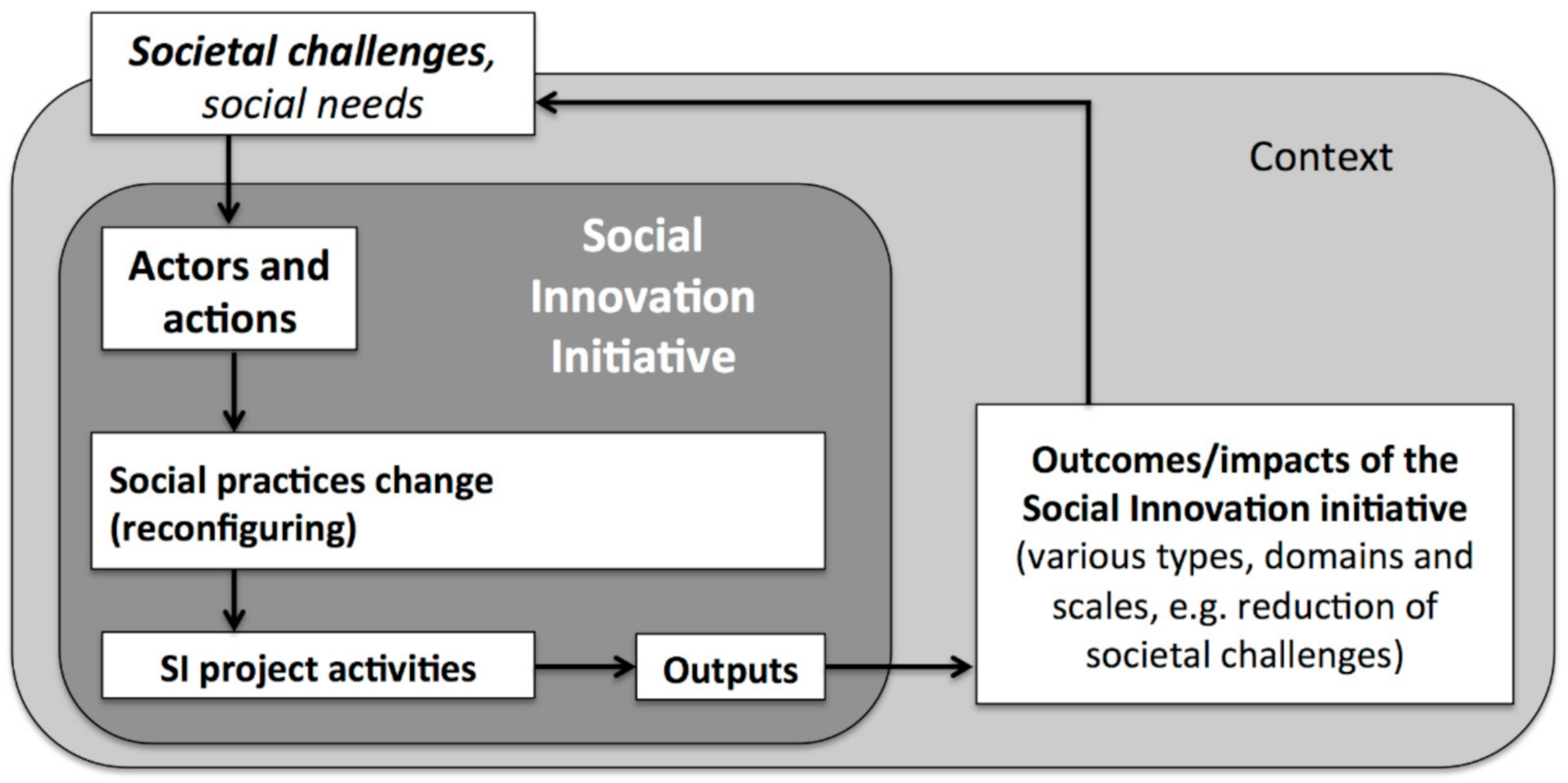
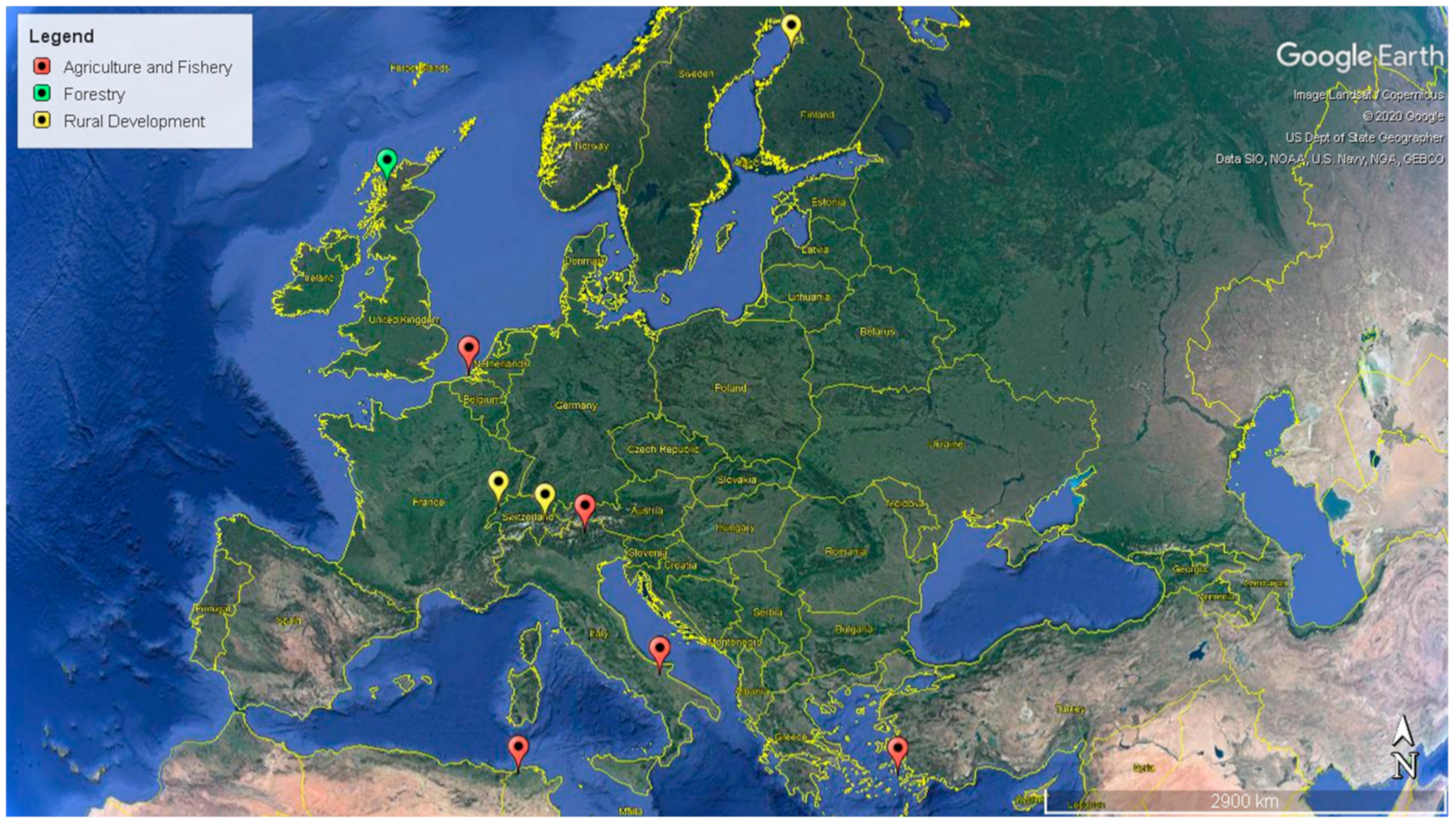
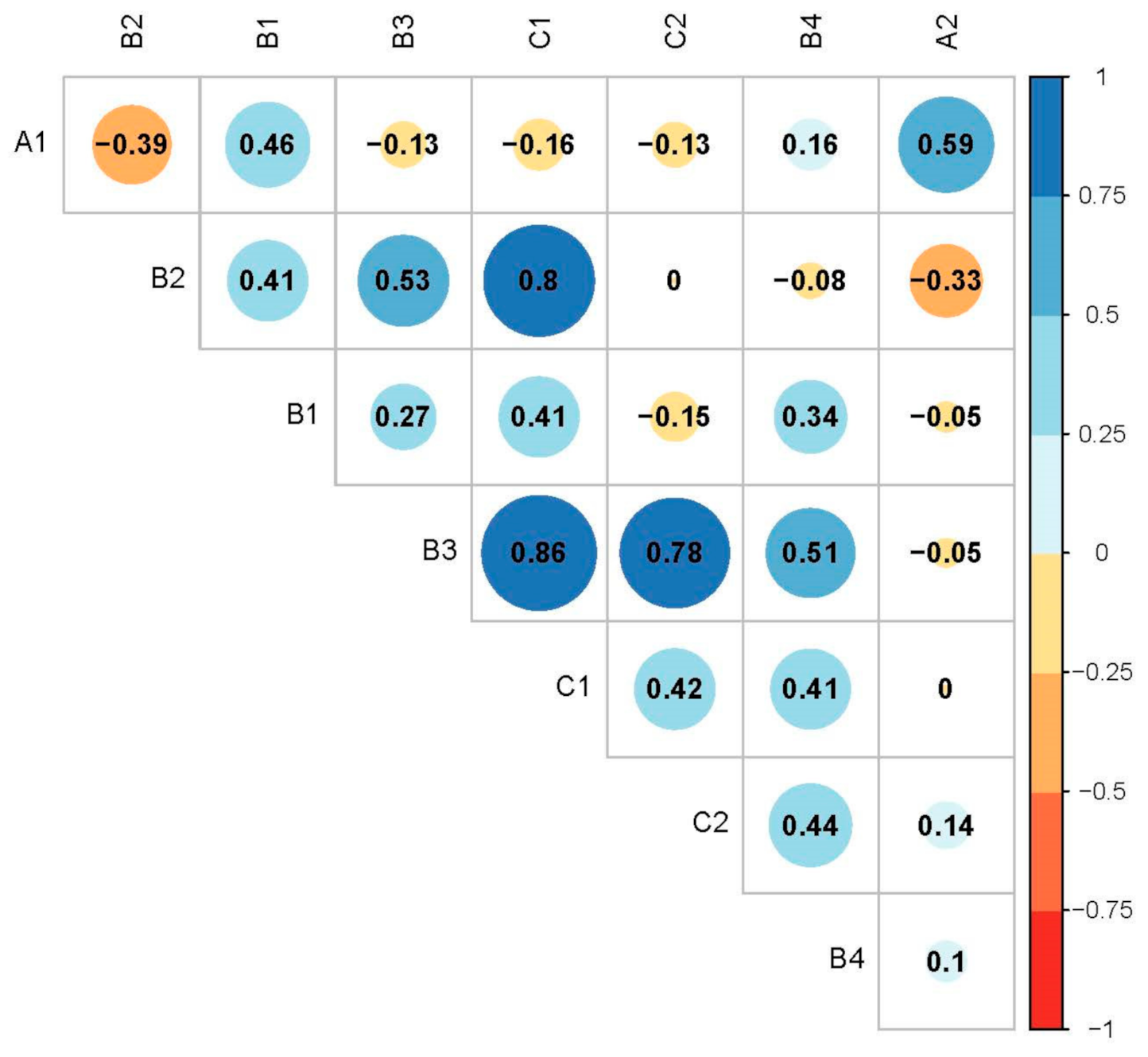
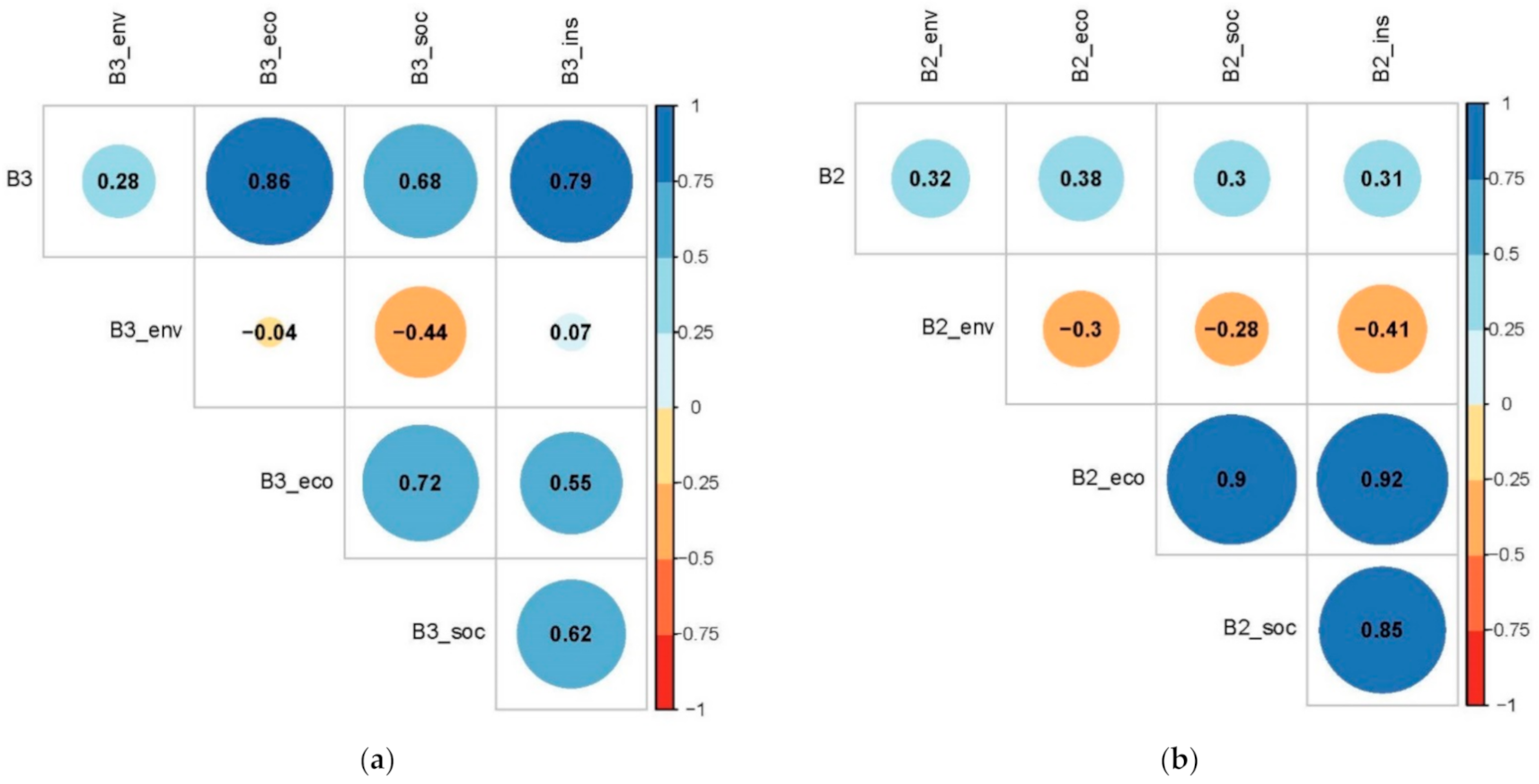
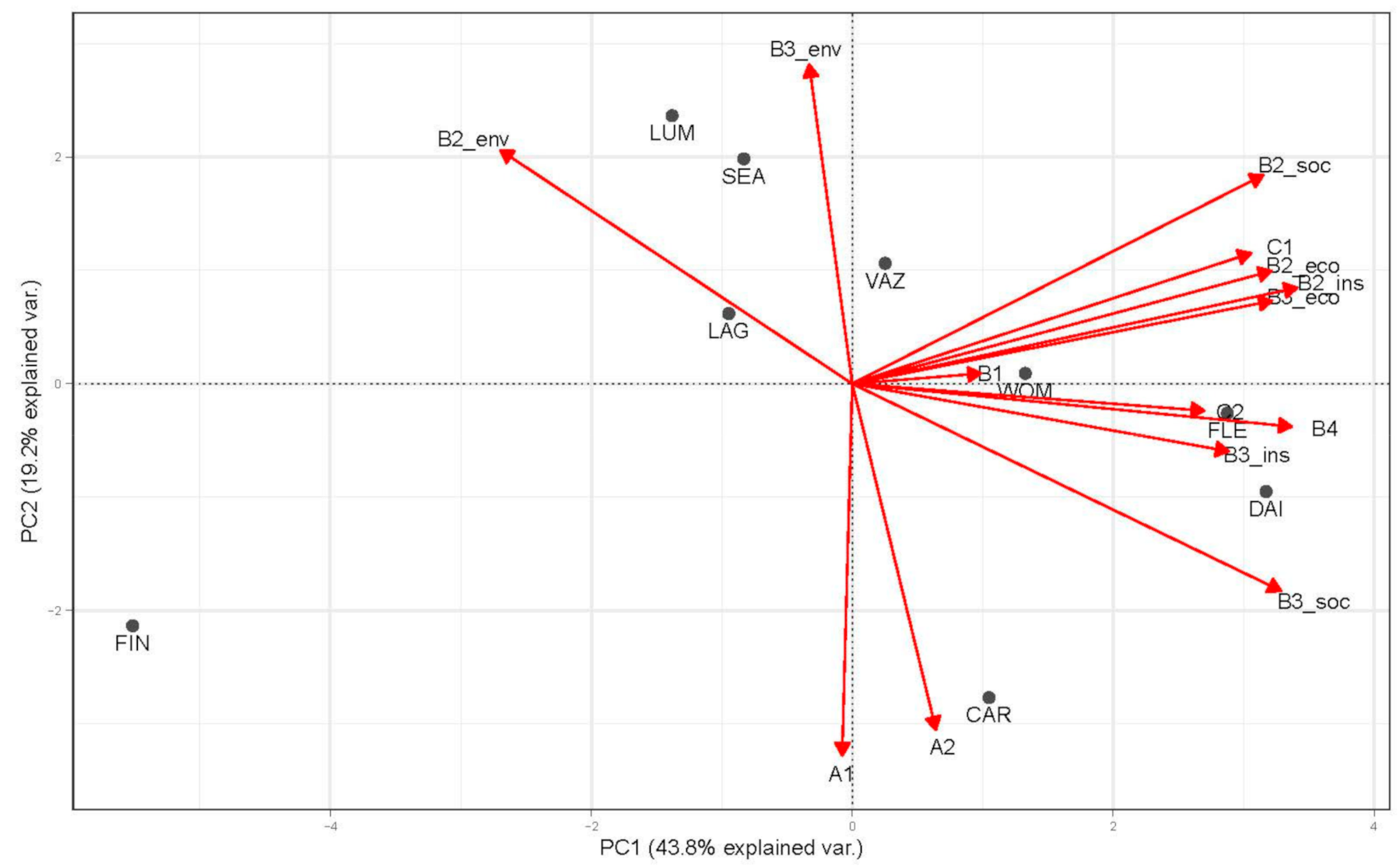
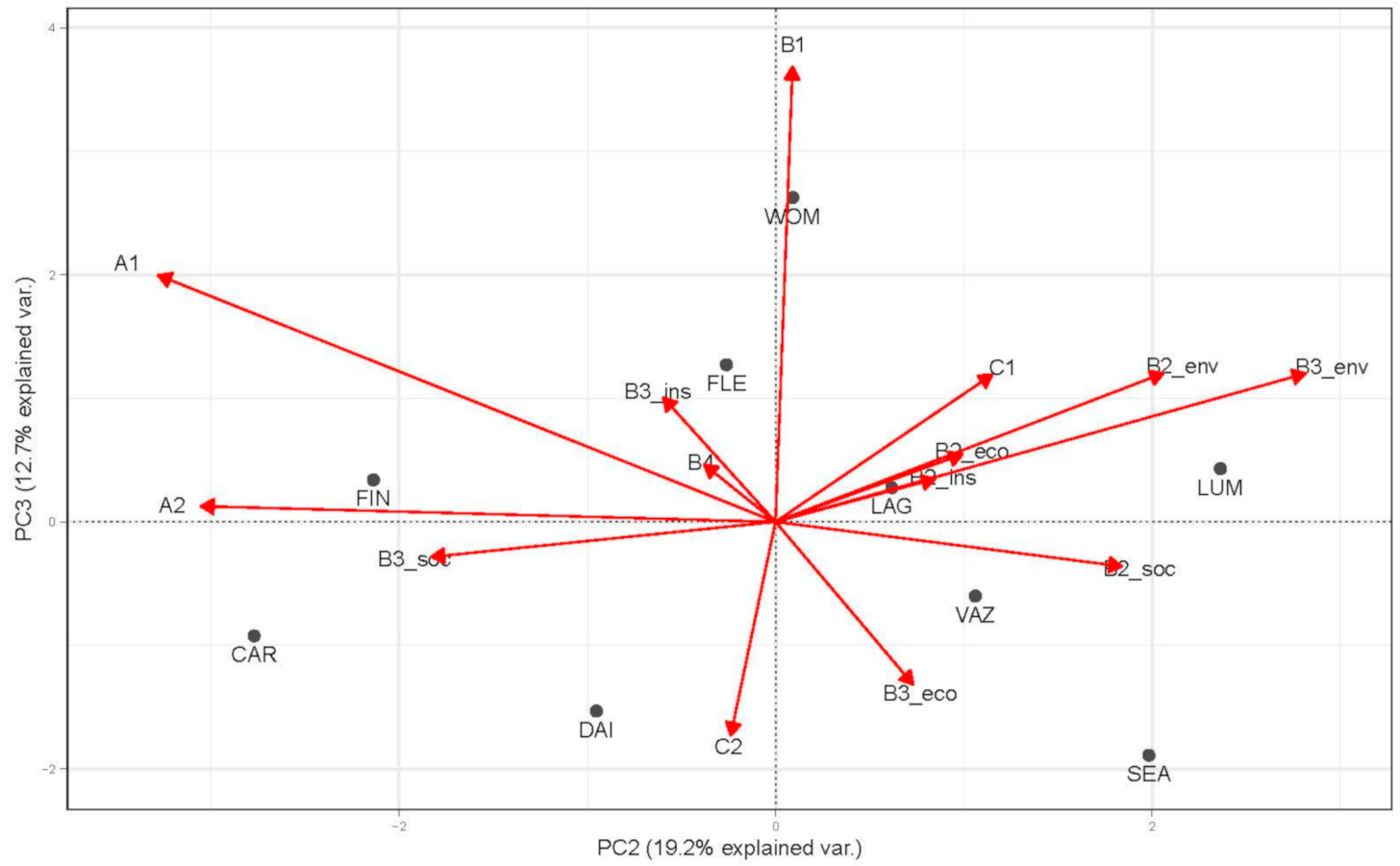
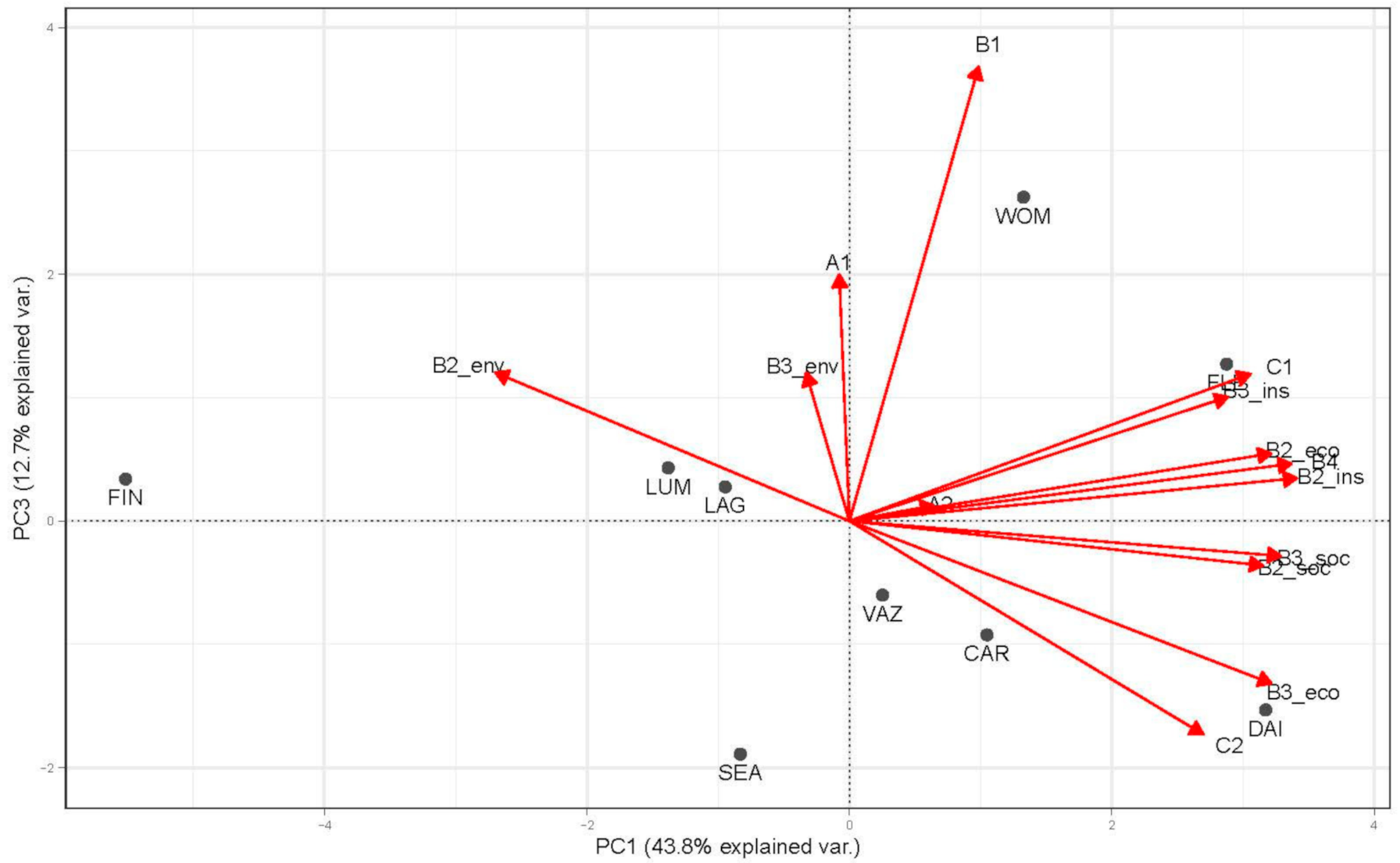
| ID | Name of the SI Initiative with Brief Description | Location | Sector and Focus | Type of Marginality | Duration |
|---|---|---|---|---|---|
| WOM | Learning Growing Living with Women Farmers is a social cooperative offering delocalized childcare service provision on the farms. | South Tyrol (Italy) | Agriculture and Fishery: social farming | Socio- economic | 2006 – Present |
| CAR | Green Care Farm is a private company handling the rearrangement of a farm into a green care farm for socio–economic integration of people with disabilities. | Walcheren Peninsula (The Netherlands) | Agriculture and Fishery: community agriculture | Physical constraints; limited infrastructures | 2003 – Present |
| VAZ | VàZapp is a rural hub association promoting career opportunities for young people seeking to rejuvenate farmer entrepreneurship and create new business models. | Foggia (Italy) | Agriculture and Fishery: networking | Socio- economic | 2010 – Present |
| DAI | Dairy Producer is a public–private partnership transferring extension and milk control activities from national institutions to Producers Organizations. | El Jem, Hazeg and Beni Hassen, (Tunisia) | Agriculture and Fishery: networking | Socio- economic | 2010 – Present |
| SEA | A Box of Sea is a project concerning the creation of a fairer market that protects the marine environment, supports small fishing communities, and provides better information to consumers regarding seafood. | Leros and Lesvos (Greece) | Agriculture and Fishery | Physical constraints; socio-economic | 2016 – Present |
| FIN | Noidanlukko Cooperative is a grassroots network and platform aiming to document, communicate, and share knowledge on environmental issues and human–nature relationships, especially concerning nuclear power and other mega-projects planned in the area. | Pyhäjoki (Finland) | Rural Development:local development | Opponents of nuclear power marginalized in public discourses and policy. | 2017–2019 |
| LUM | Pro Val Lumnezia is a public–private partnership between young entrepreneurs, municipalities, and an environmental NGO created to stabilize a declining rural Alpine valley towards a sustainable tourism. In a reorganized form as an association, it has begun to cooperate with second homeowners on a regional level (Surselva region). | Val Lumnezia, Grisons (Switzerland) | Rural Development: local development | Socio- economic | 1986 – Present |
| FLE | Réseau Urbain Neuchâtelois (Urban Network Neuchâtel) is a public–private partnership based on a regional contract established in 2007. It aims to strengthen the connection and cohesion within the Jura region as well as maintaining and developing its manufacturing profile. | Canton of Neuchâtel, (Switzerland) | Rural Development:urban–rural linkages | Socio- economic; inter-cantonal disparities | 2007 – Present |
| LAG | Lochcarron Community Development Company is a nonprofit organization about community involvement in decision-making processes on woodland ownership, known as Community Forestry, and its strategic management for local development. | Strathcarron, (Scotland, UK) | Forestry: forest management | Physical constraints; limited infrastructures | 2009– Present |
| SI Initiative | Focus Group Participants | Semi-Structured Interviews | Structured Interviews | |||||
|---|---|---|---|---|---|---|---|---|
| Core Group | Policy Makers and External Experts | Core Group | Network Members | Project Partners | Beneficiaries | |||
| WOM | 4 | 1 | 3 | 2 | 4 | 8 | 7 | |
| SEA | 10 | 2 | 0 | 2 | 12 | 4 | 9 | |
| VAZ | 10 | 3 | 3 | 3 | 25 | 0 | 10 | |
| LUM | 7 | 4 | 3 | 1 | 10 | 1 | 6 | |
| FIN | 9 | 6 | 3 | 1 | 2 | 1 | 6 | |
| CAR | 7 | 4 | 2 | 1 | 3 | 3 | 16 | |
| DAI | 9 | 10 | 0 | 2 | 6 | 1 | 1 | |
| LAG | 5 | 2 | 5 | 1 | 1 | 3 | 5 | |
| FLE | 5 | 2 | 1 | 2 | 4 | 2 | 2 | |
| TOTAL | 66 | 44 | 24 | 19 | 67 | 23 | 62 | |
| Category of Impacts | Name and Meaning of Indicator | Respondent Type | |
|---|---|---|---|
| A. Type of Impact | A1 | Proportion of marginalization problems improved by the SI initiative, as perceived by stakeholders | Stakeholders taking part in the focus group |
| A2 | Level of improvement in European societal challenges due to the SI initiative, according to actors. | Core group; project partners | |
| B. Domains of Impacts | B1 | Balance between positive to negative significant impacts due to the SI initiative in the four domains according to the perceptions of stakeholders | Stakeholders taking part in the focus group |
| B2 | Proportion of the number of impacts of the SI initiative in the four domains which were positive, according to the stakeholders | Stakeholders taking part in the focus group | |
| B2_soc | Social domain e.g., life satisfaction and happiness, solidarity and mutual trust among the members of the community, civic engagement | ||
| B2_eco | Economic domain e.g., household income; employment opportunities and quality; labor conditions in the sector in the territory | ||
| B2_env | Environmental domain e.g., pollutant emissions to air; landscape and ecosystems; biodiversity | ||
| B2_ins | Institutional domain e.g., stakeholder empowerment and representativeness in decision-making process; capability of public administrations to manage collaboration | ||
| B3 | Level of effects of the SI initiative in the four domains, according to the actors | Core group; project partners; beneficiaries | |
| B3_soc | Same as B2_soc | ||
| B3_eco | Same as B2_eco | ||
| B3_env | Same as B2_env | ||
| B3_ins | Same as B2_ins | ||
| B4 | Level of improvement in governance aspects due to the SI initiative, according to the actors | Core group; project partners | |
| C. Scale of Impacts | C1 | Level of effects of the SI initiative inside the territory in the four domains, according to the actors | Core group; project partners; beneficiaries. |
| C2 | Level of effects of the SI initiative outside the territory in the four domains, according to the actors | Core group; project partners; beneficiaries. | |
Publisher’s Note: MDPI stays neutral with regard to jurisdictional claims in published maps and institutional affiliations. |
© 2021 by the authors. Licensee MDPI, Basel, Switzerland. This article is an open access article distributed under the terms and conditions of the Creative Commons Attribution (CC BY) license (http://creativecommons.org/licenses/by/4.0/).
Share and Cite
Ravazzoli, E.; Dalla Torre, C.; Da Re, R.; Marini Govigli, V.; Secco, L.; Górriz-Mifsud, E.; Pisani, E.; Barlagne, C.; Baselice, A.; Bengoumi, M.; et al. Can Social Innovation Make a Change in European and Mediterranean Marginalized Areas? Social Innovation Impact Assessment in Agriculture, Fisheries, Forestry, and Rural Development. Sustainability 2021, 13, 1823. https://doi.org/10.3390/su13041823
Ravazzoli E, Dalla Torre C, Da Re R, Marini Govigli V, Secco L, Górriz-Mifsud E, Pisani E, Barlagne C, Baselice A, Bengoumi M, et al. Can Social Innovation Make a Change in European and Mediterranean Marginalized Areas? Social Innovation Impact Assessment in Agriculture, Fisheries, Forestry, and Rural Development. Sustainability. 2021; 13(4):1823. https://doi.org/10.3390/su13041823
Chicago/Turabian StyleRavazzoli, Elisa, Cristina Dalla Torre, Riccardo Da Re, Valentino Marini Govigli, Laura Secco, Elena Górriz-Mifsud, Elena Pisani, Carla Barlagne, Antonio Baselice, Mohammed Bengoumi, and et al. 2021. "Can Social Innovation Make a Change in European and Mediterranean Marginalized Areas? Social Innovation Impact Assessment in Agriculture, Fisheries, Forestry, and Rural Development" Sustainability 13, no. 4: 1823. https://doi.org/10.3390/su13041823
APA StyleRavazzoli, E., Dalla Torre, C., Da Re, R., Marini Govigli, V., Secco, L., Górriz-Mifsud, E., Pisani, E., Barlagne, C., Baselice, A., Bengoumi, M., Dijskhoorn-Dekker, M., Labidi, A., Lopolito, A., Melnykovych, M., Perlik, M., Polman, N., Sarkki, S., Vassilopoulos, A., Koundouri, P., ... Nijnik, M. (2021). Can Social Innovation Make a Change in European and Mediterranean Marginalized Areas? Social Innovation Impact Assessment in Agriculture, Fisheries, Forestry, and Rural Development. Sustainability, 13(4), 1823. https://doi.org/10.3390/su13041823













